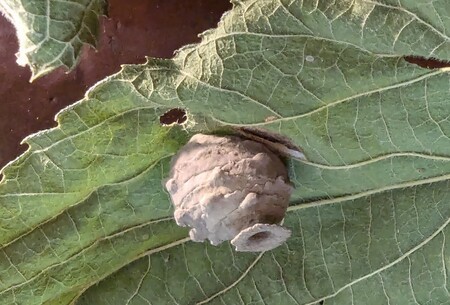
Good Natured: Potter Wasp's Nest
Some folks live in houses decorated with sophisticated 'objets d’art': vases, figurines, and other fine—and fragile—pieces. My uncle Lyman, for example, was a collector of Capodimonte porcelain, and I distinctly remember sitting on my hands every time we visited, lest I take out an irreplaceable statue or lamp with an ill-placed dramatic gesture.
The décor at Casa Otto, by contrast, is all about durability. The most delicate items are of sentimental value more than anything else: a pair of stoneware jugs, relics from my mom’s farming heritage, and a 5-gallon Red Wing crock that I still use, carefully, when making sauerkraut.
Last week, though, I had to break my Nothing Breakable approach to interior design when I found, quite by accident, a most exquisite little vessel in, of all places, a hackberry sapling.
I was doing some much-needed brush clearing along the south side of the house, using a combination of pruners, loppers, and a bow saw. I was happily clipping away when, just by luck, I noticed something dangling from one of the hackberry leaves.
At first, the little blob looked like nothing more than a splotch of mud flung onto the leaf. But that didn’t really make sense, given our extended period of dryness. When was the last time we had even a little mud, let alone enough to fling? And who, or what, would be the flinger?
I moved in for a closer look and saw that the little lump was most definitely not a random glob. It was a piece of pottery in its purest form, rounded at the bottom and with a little lip on top, suspended upside down on the underside of the leaf.
Without a doubt, this tiny earthen object was the work of a potter wasp.
Potter wasps belong to the genus Eumenes, a relatively small group of eight North American species. In our area, that is, northeastern Illinois, E. fraternus, commonly known as the fraternal potter wasp, is the most common.
As wasps go, this species falls into the black-and-creamy-white appearance category. The majority of the body is shiny black, with an elongated narrow “waist,” while the ivory markings include a few narrow bands and two distinct dots on the abdomen. You have to look pretty closely, as even the largest females measure less than ¾ inch in length.
Getting back to the nest… I’m not exactly sure how long it had been hanging there, so it could well date to earlier in the year when rain and mud were common. But as I did a little digging (later that night, online), I learned that a lack of precipitation isn’t a big deal for potter wasps.
Unlike their distant cousins the mud daubers, which need to gather wet soil, potter wasps actually gather water and soil separately and do the mixing themselves. A birdbath, lawn sprinkler, or even heavy dew will suffice. The female performs this mudball mixing task many times over for each little pot, or brood cell, she makes.
Further, her artistry isn’t confined to just one jug. She’ll make one after another, depositing a single egg in each, until her supply of eggs is depleted or until she is otherwise unable to complete her duties. (I wasn’t able to find any information on specific predators, but I would imagine spiders and birds might make that list, were one to be created.)
After completing her parental duties, the female moves on, and her offspring is officially on its own. Inside its tiny chamber, the developing larva feeds on the caterpillars, which are—in typical wasp fashion—paralyzed by stings but still alive. After progressing through a series of developmental stages, or instars, the larva pupates, and then the fully formed wasp busts through the pottery to begin its adult life.
When they’re not creating tiny works of functional art, female potter wasps also serve as pollinators; in fact, males do too. Their primary food source is nectar, which they gather by visiting flowers, and in the process, moving pollen from place to place.
Fall is traditionally the time of year when I begin my “leave the leaves” pleas, and potter wasps are one of many, many reasons why. With our recent frosts, the work of the adults is at or very near its end. But next year’s wasps have already been made. They are going to wait out winter as embryos inside their pots, many of which are on leaves, and will develop when warm weather returns next spring. Keep an eye out for these mud vessels, and if they’re sealed shut, please let them be.
Some folks collect Wedgwood or Limoges, or that local favorite, Haegar. But as far as I’m concerned, you can’t beat an original Eumenes. Just be sure to check that it’s unoccupied first!
Pam Otto is the outreach ambassador for the St. Charles Park District. She can be reached at potto@stcparks.org.

